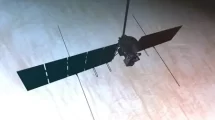 ViaSat Inc has announced it supplied NASA and its partners, with high-quality airborne satellite broadband communications for research purposes during the August 21 Great American solar eclipse.
ViaSat Inc has announced it supplied NASA and its partners, with high-quality airborne satellite broadband communications for research purposes during the August 21 Great American solar eclipse.
Using its satellite broadband network coupled with its airborne satcom terminals mounted onto two of NASA’s WB-57 high altitude research aircraft, ViaSat enabled a successful HD video live stream of high-resolution images of the Sun’s corona, its outer atmosphere, during totality of Monday’s total solar eclipse, and provided two-way communication between the planes and controllers on the ground. This link was critical in helping the team complete this historic mission, and the live stream was included in NASA’s nationwide broadcast of the total eclipse. The ViaSat data link was also instrumental in acquiring rare infrared observations of Mercury that will be used to attempt the first-ever “thermal images” of its night-side surface, which was visible to these high-altitude aircraft during the eclipse window.
“We have maintained a partnership with NASA – supplying advanced satellite-based broadband communications – for many years,” said Ken Peterman, president, Government Systems, ViaSat. “We are proud to have supported NASA and its partners during their solar eclipse research endeavours, delivering a high-speed, high-performance satellite system backbone to satisfy their immediate research needs.”
ViaSat’s broadband network is a proven, reliable, satellite-based network in operation for more than a decade. It offers a combination of Ka-band and Ku-band connectivity, and gives thousands of government aircraft, heads of state, commercial aircraft, business jets, maritime vessels, residential subscribers and enterprise users enhanced connectivity and coverage. Users benefit from ViaSat’s continuous investment in network coverage, security, operations and broadband data capacity density.












Add Comment